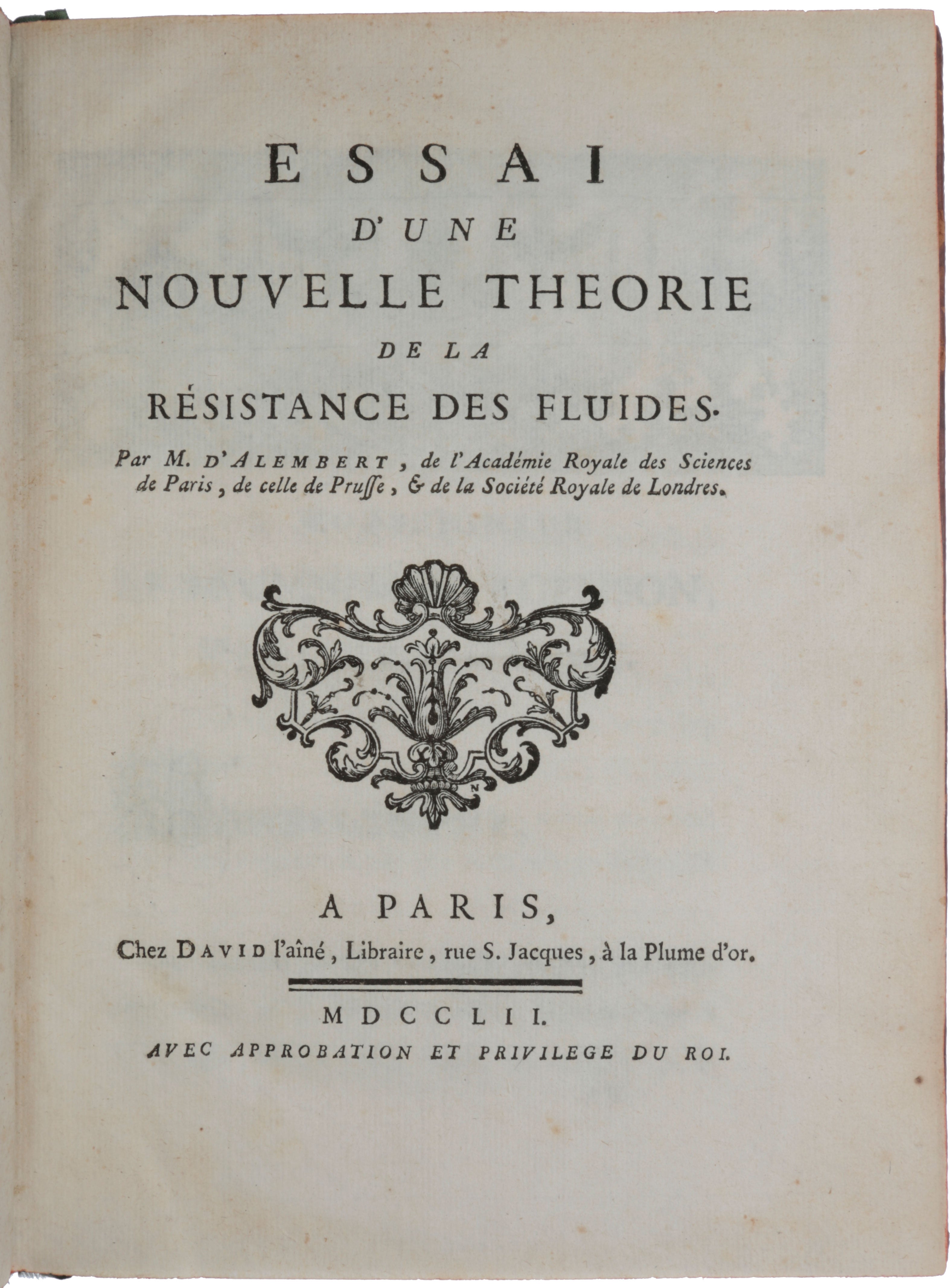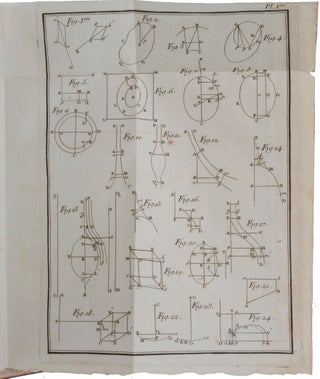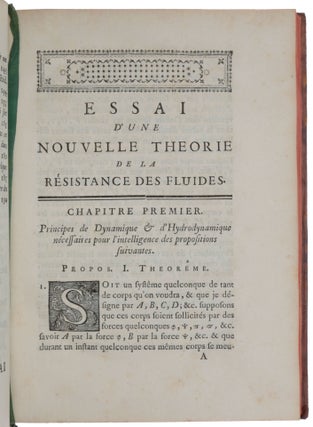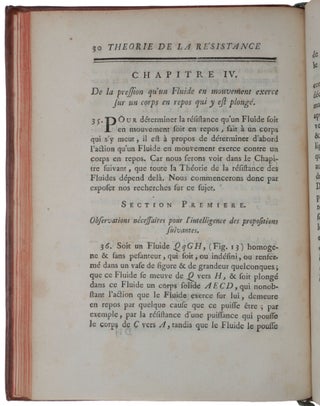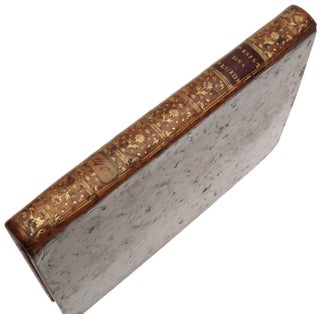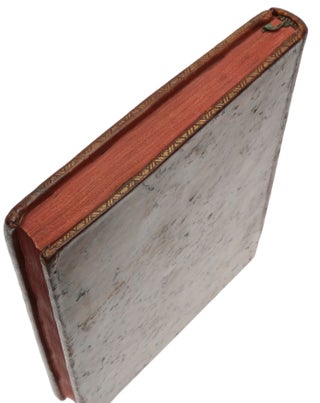Essai d’une nouvelle théorie de la résistance des fluides.
Paris: David l’aîné, 1752. First edition of one of d’Alembert’s most important books. “It is recognised that the New Theory of the Resistance of Fluids was a turning point in the genesis of Fluid Mechanics: for the first time the motion of a fluid was reduced to two differential equations in partial derivatives relating the velocities and positions. Therefore, the physical problem of fluid motion was converted into a mathematical one” (Calero, p. v). The Essai is famous for a number of ‘firsts.’ “The Essai … is a turning point both in physics and mathematics. It contains the first field description of media in motion, a description which in other hands led quickly to partial differential equations and in particular to potential theory. It contains also what is generally described as d’Alembert’s solution of [Laplace’s] equation d2φ/dx2 + d2φ/dy2 = 0 in the form φ = f(x + iy) + g(x – iy) … The analysis is contained in §§57-60, which are famous for the first appearance of the ‘Cauchy-Riemann equations’ … In §70 appears the famous ‘d’Alembert paradox’. Put in modern terms, this ‘paradox’ asserts that a submerged fluid body moving at uniform speed in a continuous irrotational flow of an ideal fluid at rest at infinity experiences no resultant force … three years later Euler proved that irrotational motion is only a very special case: and in rotational motion, the d’Alembert paradox no longer holds. Through proper development and exploitation of this idea, the modern theory of airplane lift has developed” (Truesdell 1953, pp. 450-451). “The Essay was an important contribution. Hunter Rouse and Simon Ince have said that d’Alembert was the first ‘to introduce such concepts as the components of fluid velocity and acceleration, the differential requirements of continuity, and even the complex numbers essential to modern analysis of the same problem’” (DSB). The Essai is the published version of d’Alembert’s submission to the Prussian Academy, which in 1748 had announced a prize competition on the resistance of fluids. “He was not awarded the prize; indeed, it was not given to anybody. The Prussian Academy took this action on the ground that nobody had submitted experimental proof of the theoretical work. There has been considerable dispute over this action. The claim has been made that d’Alembert’s work, although the best entered, was marred by many errors. D’Alembert himself viewed his denial as the result of Euler’s influence, and the relations between the two men deteriorated further” (ibid.). ABPC/RBH record two copies since Norman. Provenance: Carlo Ignazio Giulio (1803–59), Italian mathematician, mechanical engineer and politician (small bookplate to front free endpaper). Giulio was professor of physical and mathematical sciences at the University of Turin from 1832, rising to become rector in 1844. He was president of the Weights and Measures Commission, collaborating with Amedeo Avogadro on the implementation of the new metric system. In 1848 Giulio was appointed senator. D’Alembert’s first foray into hydrodynamics is found in an appendix to his great Traité de dynamique (1743), which introduced ‘d’Alembert’s principle’. This stated that ‘the internal forces of inertia must be equal and opposite to the forces that produce the acceleration’; it was used by d’Alembert to reduce problems of motion to problems of static equilibrium. In the same year, Alexis-Claude Clairaut published his analysis of the shape of the Earth (Théorie de la figure de la terre). This necessitated a study of hydrostatics, since he treated the Earth as a rotating body free to take on any form required by the acting forces. In the following year, d’Alembert published his first detailed work on hydrodynamics, the Traité de l’équilibre et du mouvement des fluides (1744), in which he “used his principle to describe fluid motion, treating the major problems of fluid mechanics that were current. The sources of his interest in fluids were many. First, Newton had attempted a treatment of fluid motion in his Principia, primarily to refute Descartes’s tourbillon theory of planetary motion. Second, there was a lively interest in fluids by the experimental physicists in the eighteenth century, for fluids were most frequently invoked to give physical explanations for a variety of phenomena, such as electricity, magnetism, and heat. There was also the problem of the shape of the earth: What shape would it be expected to take if it were thought of as a rotating fluid body? … Furthermore, the vis viva controversy was often centered on fluid flow, since the quantity of vis viva was used almost exclusively by the Bernoullis in their work on such problems. Finally, of course, there was the inherent interest in fluids themselves. D’Alembert’s first treatise had been devoted to the study of rigid bodies; now he was giving attention to the other class of matter, the fluids” (DSB). Although the Traité de l’équilibre essentially reproduced other scientists’ results using different methods, it helped inform d’Alembert’s next and more original work, Essai d’une nouvelle théorie de la résistance des fluides. “In 1748 the Berlin Academy proposed as the subject for the prize competition of 1750 the theory of the resistance of fluids. The tentatives of Newton were known to be wrong, and nothing but empirical formulae had taken their place. The subject, besides being close to the unexplored foundations of the concept of inertia, was thus of great mathematical interest and practical moment. “In December 1749, d’Alembert sent to Berlin his entry, a long Essai d’une nouvelle théorie de la résistance des fluides. The Academy, of which d’Alembert was a non-resident member, judged that no contestant had earned the prize, sent back all the manuscripts, and urged the authors to compare their predictions with the results of experiment. D’Alembert withdrew at once, and in 1752 he published his essay. In the introduction d’Alembert details the circumstances in angry and sarcastic terms. “At the time of the contest Euler was director of the Mathematical Division of the Berlin Academy. It seems difficult to believe that he could have expected seriously that a theory of fluids could give results in accord with existing experiments on the resistance suffered by submerged bodies. The data itself was confused and sometimes contradictory. Nearly all the experiments concerned turbulent flow; they were not to be understood even qualitatively for a full century following; and to the present day the phenomenon of resistance remains as far as any rigorous theory is concerned a partially open question” (Truesdell 1953, pp. 445-446). “The first half of the introduction [of the Essai] is a brilliant and elegant critique of the state of hydrodynamics in 1750. Newton’s two theories of fluids are carefully distinguished and fairly described in principle and in result. The corpuscular theory is ‘a research of pure curiosity … not applicable to nature.’ The proofs of results on compressed fluids are ‘a sort of approximation and groping’ based on ‘a method certainly very ingenious but insufficient and faulty’, self-contradictory, and ‘intended to elude rather than surmount the difficulty of the problem … Despite all these observations, we ought not the less to admire the efforts and the sagacity of this great philosopher, … the first who dared beat out a path for the solution of a problem which no one before him had attempted. Also, this solution, although hardly exact, shines throughout with that inventive genius, that spirit rich in resources, which no one has possessed in a higher amount than he.’ “The many geometers who have attacked Newton’s theory of resistance ‘have been no more successful than he; almost all have given us in place of the true principles many calculations.’ The one exception is Daniel Bernoulli; but his results on bodies struck by a jet are not correct for submerged bodies, and his formulae for submerged bodies rest on insufficient hypotheses and do not agree with experiments. “Here we shall find a ‘method entirely new, without borrowing anything from those who preceded me in the same work. The theory … whose principles I shall give has the advantage of not being based on any arbitrary assumption: I suppose only, as no one can contest, that the fluid is a body composed of particles which are very small, detached, and capable of moving freely.’ The discussion which follows reduces resistance to loss of motion; moreover, in d’Alembert’s other treatises he has reduced the laws of motion to those of equilibrium; and hydrostatics has been reduced by the philosophers to ‘the single principle of experience, the equality of pressure in all directions.’ But since ‘I have proposed to demonstrate everything in all rigor, … it has not been without trouble that I have succeeded in demonstrating the truths which have been most generally recognised and least exactly proved up to now … It seems even very probable to me that at least in certain cases the solution of the problem by analysis will be altogether impossible.’ Further, ‘the difficulty of calculation would perhaps make it impossible for me to compare the theory with experiment …’ “The chapter headings are as follows: I. Principles of dynamics and of hydrodynamics necessary for the understanding of the following propositions. II. General principles of the equilibrium of fluids. III. General principles of the pressure of fluids, either in motion or in repose. IV. On the pressure which a fluid in motion exerts on a body at rest submerged therein. V. On the resistance of fluids to bodies which move in them. VII. On the oscillation of a body which floats on a fluid. VII. On the action of a jet of fluid which emerges from a vessel and strikes upon a plane. VIII. Application of the principles explained in this essay to the investigation of the motion of a fluid in a vessel. IX. Application of the same principles to some investigations on the flow of rivers. Appendix. Reflections on the laws of equilibrium of fluids” (Truesdell 1954, pp. L-LI). “In his Essai d’une nouvelle théorie de la résistance des fluides, d’Alembert sought to adapt Clairaut’s analysis to the general motion of fluids. He first assumed that fluid matter was composed of a great number of particles moving freely with respect to one another but – as in static equilibrium – transmitting pressure equally in all directions. Whereas he readily admitted that one could not predict the detailed arrangement of particles, he regarded them as subject – like solid bodies – to his general principle of dynamics. He then proceeded to a detailed evaluation of the forces exerted upon an immersed body of oval form as a result of the acceleration and deceleration of the fluid particles which displacement of the body at uniform speed entailed. “D’Alembert’s mathematical manipulations were, judged by present-day standards, cumbersome and difficult to follow. But they were definitely original. He was the first, for example, to introduce such concepts as the components of fluid velocity and acceleration, the differential requirements of continuity, and even the complex numbers essential to modern analysis of the same problem. Like Newton, d’Alembert mistakenly assumed a small zone of stagnant fluid to exist at the front of the body to avoid the abrupt change in direction which he thought would otherwise occur. Unlike Newton, however, he could see no reason for assuming conditions in the rear to be any different from those in the front, and his summation of the elementary pressures exerted on each part of the body surface hence led to the paradoxical result of zero longitudinal force on the body. He himself doubted the physical significance of this result: ‘Thus, I do not see, I admit, how one can satisfactorily explain by theory the resistance of fluids. On the contrary, it seems to me that the theory, in all rigor, gives in many cases zero resistance; a singular paradox which I leave to future Geometers for elucidation’” (Rouse & Ince, pp. 101-102). Among the major features of the Essai is the integration of differential forms involving complex variables that d’Alembert presented in Sect. III, §§57–60. There d’Alembert discussed the problem of determining the velocity of a fluid at a point under given conditions. He showed that his dynamical principle, together with the requirement of the continuity of the flow, implied that the components u and v of the velocity of the fluid in the x- and y-directions must be such “that the forms u dx + v dy and v dx - u dy were exact differentials [i.e., the differentials of functions of x and y]. This property holds, he ingeniously noted, if and only if (u - iv) (dx + i dy) is an exact differential. This means that u and -v are the real and imaginary parts of a (holomorphic) function of the complex variable x + iy. Here [pp. 60-61] d’Alembert discovered the Cauchy-Riemann condition for u and -v to be the real and imaginary components, respectively, of an analytic function in the complex plane, as well as a powerful method to solve Laplace’s equation in two dimensions” (Darrigol, pp. 21-22). “One could add that in this passage d’Alembert also hinted at what were to become known as complex potentials. According to Truesdell [1954], d’Alembert’s claim that these equations hold, ‘i.e., that all flows are potential flows … began a controversy that lasted for a century’” (Botazzini & Gray, p. 87). “What was the true reason the prize was not awarded to d’Alembert? This is an open question that we cannot answer. Clifford Truesdell, one of the most renowned historians of Mechanics in the last century, made some conjectures about it, which are not very favourable to d’Alembert. He thinks that it seems very improbable for Euler to have expected that the experiments could provide some results in accordance with the theories. This is very likely true. The available experiments were quite few in number, inconclusive, sometimes contradictory, and carried out in a very limited range of options as d’Alembert himself explains. Therefore, according Truesdell, ‘the reason given out was only a pretext, offered in place of the truth, … that d’Alembert’s reasoning was inaccurate, tortuous, incomprehensible, and that in illustration of his equations he had not succeeded in exhibiting a single flow’. We might agree with the difficulty in reading the text, and also that there are matters that bear little or no relation with fluids; but at the same time there is matter in the Essay that deserves a more favourable judgment. Besides, if it were true that Euler did not believe that practice could confirm the theory, what did he and the Jury expect for the new submission? What is more, if the veiled intention was to eliminate d’Alembert, then the winning work in the postponed contest would need to be of rather better quality, which, according to the prestige and capabilities of d’Alembert did not seem easy to expect. In the end, the almost unknown winner contributed nothing to Fluid Mechanics while d’Alembert undoubtedly did, although following quite a tortuous path. “At the end of December 1751, the Academy of Paris approved the Essai d’une nouvelle théorie de la résistance des fluides for printing. This was the French version of the Latin manuscript, which had the long title Theoria resistentiae quam patitur corpus in fluido motum, ex principiis omnino novis et simplissimis deducta, habita ratione tum velocitatis, figurae, et massae corporis moti, tum densitatis & compresionis partium fluidi. Both are basically the same although with some minor corrections, a certain reorganization and the addition of a few new articles” (Calero, pp. 136-137). “A natural son of the chevalier Destouches and Mme. De Tencin, D’Alembert was born on 16 or 17 November 1717 and was placed (rather than abandoned) on the steps of the church of Saint-Jean-le-Rond in Paris—whence his given name, although much later he preferred ‘Daremberg’, then ‘Dalembert’ or ‘D’Alembert’. He followed his secondary studies at the Quatre-Nations College in Paris, and later studied law and probably a little medicine. His first memoir was submitted to the Académie des Sciences in Paris in 1739, and he became a member of that institution in 1741. The Traité de dynamique was D’Alembert’s first major work, to be followed by many others in the 1740s and early 1750s. He was co-editor with Dénis Diderot of the Encyclopédie, for which he wrote the introduction (1751) and around 1700 articles, mainly scientific, the majority of them before the work was banned following his article ‘Genève’ in 1758–1759. He was appointed to membership of the Académie Française in 1754 and quickly became second to Voltaire in the group for philosophes. In 1772 he became permanent secretary of this academy (but not that for sciences). He died of gall-stones on 29 October 1783” (Crépel, p. 160). Bibliotheca Mechanica p. 8; Brunet II: 471; Norman 35; Poggendorff I, 28; Sotheran I, 68; Wellcome II, p. 28. Botazzini & Gray, Hidden Harmony – Geometric Fantasies. The Rise of Complex Function Theory, 2013. Calero, Jean Le Rond D’Alembert: A New Theory of the Resistance of Fluids, 2018 (an English translation of the Essai with detailed commentary). Crépel, ‘Jean le Rond d’Alembert, Traité de dynamique,’ Chapter 11 in Landmark Writings in Western Mathematics 1640-1940 (Grattan-Guinness, ed.), 2005. Darrigol, Worlds of Flow, 2005. Rouse & Ince, History of Hydraulics, 1957. Truesdell, ‘Notes on the history of the general equations of hydrodynamics,’ The American Mathematical Monthly 60 (1953), pp. 445-458. Truesdell, ‘Rational fluid mechanics, 1687-1765,’ pp. IX-CXXV in: Leonhardi Euleri Opera Omnia, Ser. 2, Vol. 12, 1954.
4to (214 x 160mm), pp. [i-vi], vii-xlvi, [1], 2-212, with two folding plates (occasional light browning and foxing). Contemporary mottled calf, spine richly gilt with red lettering-piece, red edges, marbled endpapers (old shelf label on spine, binding very lightly rubbed). An excellent unrestored copy.
Item #5809
Price: $3,500.00

